Genus Rhinopithecus Rank Species | Phylum Chordata Family Cercopithecidae Scientific name Rhinopithecus roxellana | |
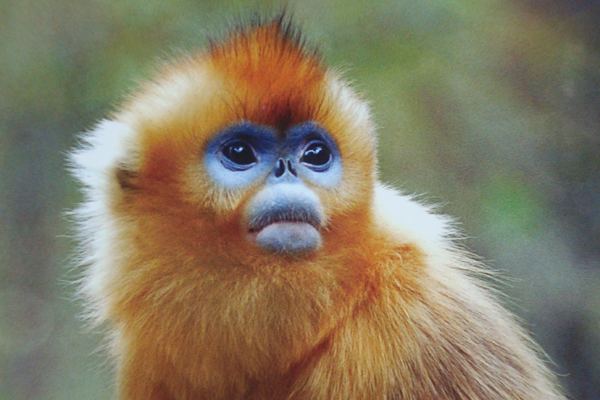 | ||
Similar Snub‑nosed monkey, Douc, Primate, Golden monkey, Black snub‑nosed monkey | ||
Humanities and geography 09 18 2015 saving the elusive golden snub nosed monkey
The golden snub-nosed monkey (Rhinopithecus roxellana) is an Old World monkey in the Colobinae subfamily. It is endemic to a small area in temperate, mountainous forests of central and Southwest China. They inhabit these mountainous forests of Southwestern China at elevations of 1,500-3,400 m above sea level. The Chinese name is Sichuan golden hair monkey (川金丝猴). It is also widely referred to as the Sichuan snub-nosed monkey. Of the three species of snub-nosed monkeys in China, the golden snub-nosed monkey is the most widely distributed throughout China.
Contents
- Humanities and geography 09 18 2015 saving the elusive golden snub nosed monkey
- Golden snub nosed monkeys in the qinling mountains
- Taxonomy
- Physical characteristics
- Habitat and distribution
- Behavior
- Reproduction
- Diet
- Social structures
- Conservation
- In Zoos
- References
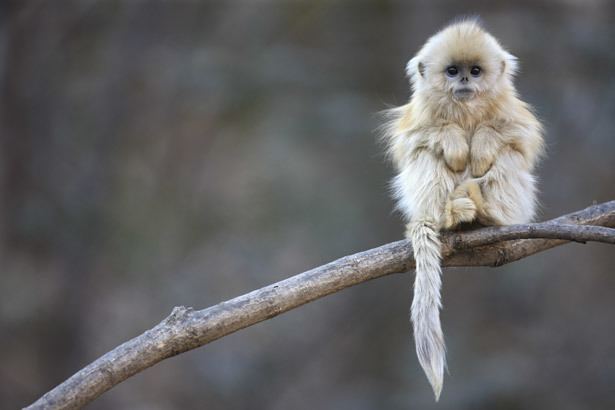
Snow occurs frequently within its range and it can withstand colder average temperatures than any other non-human primates. Its diet varies markedly with the seasons, but it is primarily an herbivore with lichens being its main food source. It is diurnal and largely arboreal, spending some 97% of its time in the canopy. There are three subspecies. Population estimates range from 8,000 to 15,000 and it is threatened by habitat loss.
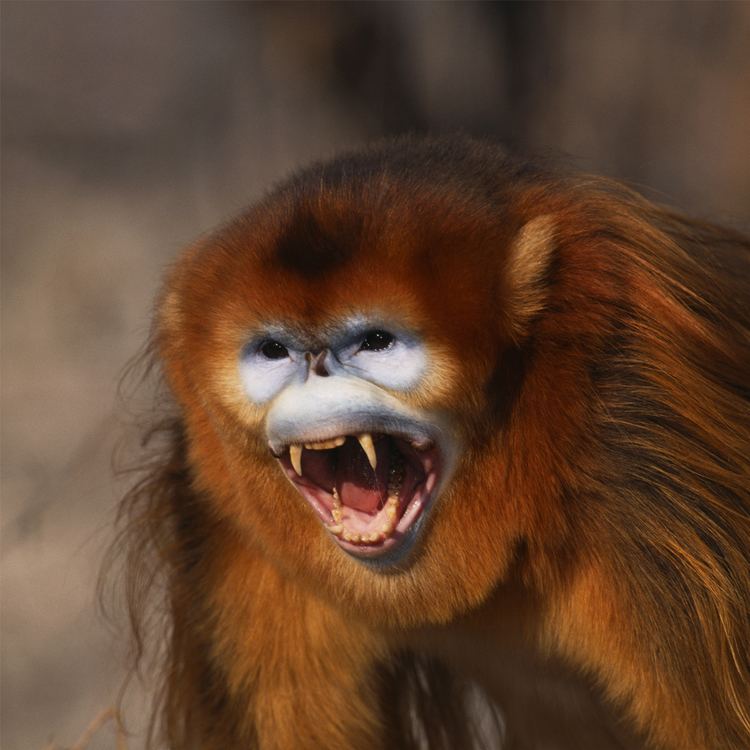
Golden snub nosed monkeys in the qinling mountains
Taxonomy
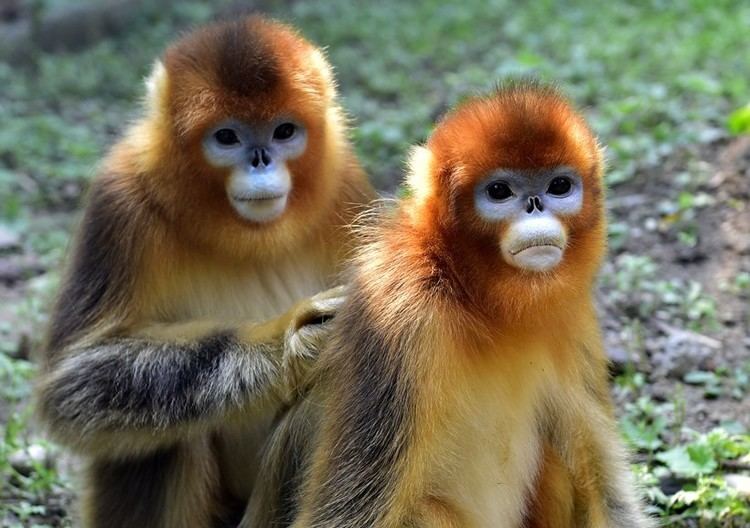
Biologists presently identify three subspecies of this monkey, which can be distinguished primarily by the length of their tails, as well as by certain skeletal and dental features. The dense human settlement of much of eastern Sichuan and the Han River valley of southern Shaanxi creates geographical separation between the three subspecies.
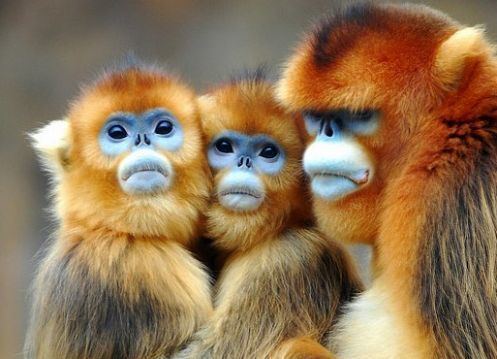
Physical characteristics
The adult and subadult golden snub-nosed monkey is sexually dimorphic.

Adult males (estimated at over 7 years of age) have large bodies covered with very long, golden guard hairs on their backs and cape area. The crest is medium brown while the back, crown to nape, arms and outer thighs are deep brown. The brown crest also contains physically upright hairs, which the shape are useful for individual identification. Also, when their mouths are open, researchers can observe long canines.
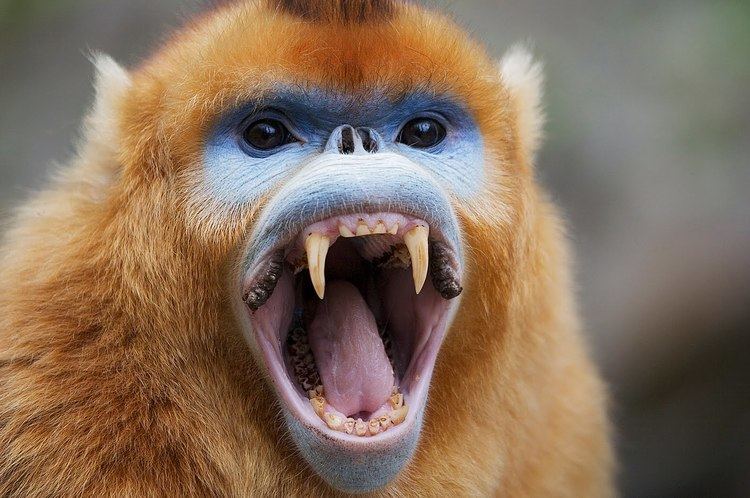
Subadult males (estimated at 5–7 years of age) have a similar sized body as the fully developed male adult, but have a more slender body. The golden guard hairs on the cape are short and sparse, and their median brown crests show microbanding, while also turning from a brown color.
Adult females (estimated at over 5 years of age) are smaller in size and are about half the size of adult males. The dorsum, crown to nape, cape, arms and outer thighs are brown to deep brown in some of the older females. However, golden guard hairs are also present on the back and cape area, but they are shorter in length than in the males. The brown crest shows microbanding. Their breasts and nipples are large and easily visible which is also useful for identification. After pregnancy, it is common to observe infants and newborns hanging beneath the abdomen of females when they are climbing or walking.
Subadult females (estimated at 3–4 years old) are smaller than adult females and are about two-thirds the size. The body hair is brown, gradually turning golden but lacking the beautiful golden guard hairs. Their median brown crest also shows microbanding. Their breasts and nipples are also not as large as they are in adult females.
Juveniles (ranging from at least 1 year of age to 3 years old) are quite small, being less than two-thirds the size of adult females. Their body hair is light brown, gradually turning reddish gold. The rest of their body (dorsum, crown to nape, cape, arms and outer thighs) hair is brown. Golden hairs in the dorsum or cape area are not recognizable nor is the median brown crest present in subadult to adult females and males. Sexual discrimination is difficult because their external genital organs are underdeveloped.
Infants (estimated at 3 months to 1 year old) are light brownish gray or light brown, appearing white in sunlight. They are often observed playing with juveniles or other infants, but are noted to spend most of their time beside their mothers or sucking milk. They are also observed clinging from the front of their mothers (primarily the lower abdomen) for protection, feeding, and nurturing. Their sex of the individual cannot be distinguished at this point of time as well as in Newborns.
Newborn babies (estimated at less than 3 months of age) are dark to light gray. They turn light brownish grey after about 2 months. They are also observed rarely leaving their mothers or other females carrying them, known as alloparenting. Sex at this time is indistinguishable.
Habitat and distribution
The distribution of the golden snub-nosed monkey is limited to temperate forests on mountains in four provinces in China: Sichuan, Gansu, Shaanxi, and Hubei. This monkey is found at elevations of 1,500-3,400 m. Within this area, vegetation varies with altitude from deciduous broadleaf forests at low elevations to mixed coniferous broadleaf forests above 2,200 m and coniferous forests above 2,600 m. Average annual temperature is 6.4 °C with a minimum of -8.3 °C in January and a maximum of 21.7 °C in July.
Home range size varies seasonally. The change in home range size and location is dependent upon the availability and distribution of food. The total area covered by seasonal home ranges is surprisingly large for a species. One of the largest home ranges found covered 40 km2.
Behavior
The golden snub-nosed monkey is found in groups ranging in size from 5-10 individuals to bands of about 600. The social organization of this species can be quite complex. The one-male-units (OMUs) are the basic social unit within groups of golden snub-nosed monkeys with many of the OMUs forming a bigger group. These multi-tier societies consist of several OMUs that include one adult male plus a number of adult females and their offspring. Some observers have even come to conclude that these large foraging groups are multi-male and multi-female societies.
The male may stay solitary, often remaining away from the rest of the group members as they rest. Adult females tend to socialize more with one another than with other males or juveniles. Group members remain close to one another, interactions between different OMUs often result in confrontations. Females of the golden snub-nosed monkey are usually observed to form several close associations with other females. However, in conflicts against other units in the surrounding site, both males and females support each other, while also protecting their young (usually observed at a distance by putting the young in the center of the pack).
Protecting the young is a group effort. Mothers often have helpers assisting them with the care of their young. When faced with danger from a predator such as the northern goshawk (Accipiter gentilis), the young are placed at the center of the group while the stronger adult males go to the scene of the alarm. The rest of the day, the members of the group remain closer to one another with the young protected at the center.
There is little information available on the sleeping cluster patterns of the Sichuan snub-nosed monkeys. However, in a detailed observation of the free-ranging band in the Qinling Mountains in central China, results have suggested that winter night activity of Rhinopithecus roxellana is a compromise between antipredator and thermoregulatory strategies and an adaptation to ecological conditions of their temperate habitat. Keeping warm is critical for survival in freezing temperatures, but their thick coats can provide this warmth as well as sleeping in these clusters. Monkeys often sleep in the lower stratum of the tree canopy, avoiding the upper canopy where it is cold and windy. They form larger sleeping clusters at night than in the daytime. The most common types of night-sleeping clusters were adult females and their young, followed by adult females with other adult females. Adult males are usually observed sleeping by themselves or on the lookout for predators or dangers.
There are several hypotheses to explain the formation of sleeping clusters, the most important one being a thermoregulatory process. The thermoregulatory hypothesis suggests that a primary function of sleeping in clusters is the conservation of heat during cold temperatures. Along with thermoregulation, safety from predators is an important principle underlying the formation of sleeping clusters in primates. This antipredation hypothesis suggest that increased cohesion and large sleeping congregations might facilitate predator detection and enhance group defense.
Reproduction
Females are sexually mature at about 5 years old. Males are sexually mature at about 5–7 years old. Mating may occur throughout the year but peaks in the month of October. This approximates gestation at 6–7 months in length. The golden snub-nosed monkey gives birth from March to June.
In primate research, although male-male competition for mates and female mate choice are the common causes of sexual selection, female-female competition over males is especially important in polygynous species. The Sichuan snub-nosed monkey is a seasonal breeding species of colobine endemic to China, and lives in a multi-level social system. Because the basic social and reproductive unit is the harem or one male unit (OMU), which consists of a single resident male, a number of adult females, sub-adult females, juveniles and infants, it has been suggested that sexual competition in this polygynous species is skewed. Females faced with multiple competitors will exhibit a high level of sexual competition, while the single resident male will not experience within-group sexual competition.
Diet
The golden snub-nosed monkey eats (from greatest to least in amount) lichens, young leaves, fruits or seeds, buds, mature leaves, herbs, bark, and flowers. This diet varies from season to season, showing a correlation once again between food availability and home range. This diet also shows a complicated seasonal variation. The monthly diet of monkeys at Shennongjia Nature Reserve varies from primarily lichen eater between November and April, to a mixture of folivore and lichen eater from May to July, and to a mixture of frugivore (or seed eater) and lichen eater or primarily lichen eater between August and October. For this seasonal variation, the amount of lichens consumed appears to decrease in the summer with the greater availability of fruit or seeds. The monkeys' preferred lichen species seem to grow on Cerasus discadenia, Salix wallichiana, and Malus halliana. Lichens are found in great profusion on dead trees. Monkeys at Qingmuchuan Nature Reserve have not been observed to feed on lichen; during the winter they feed mostly on leaves, bark, and buds, and during the summer they feed mostly on the fruit of the giant dogwood.
This primate prefers to forage in larger trees of a tree species, and spends most of the time using primary forest and young forest, rarely uses shrub forest and does not use grassland. Even though they primarily forage in the trees and sometimes on the ground, they have several predators, including both mammals, such as dhole (Cuon alpinus), wolf (Canis lupus), Asiatic golden cat (Catopuma temmincki), and leopard (Panthera pardus), and birds, like golden eagle (Aquila chrysaetos) and northern goshawk (Accipiter gentilis).
Social structures
The fundamental level of social organization is the one-male, multifemale social unit (OMU), which contains a single breeding male, several breeding females (harem) and their offspring. There also exist all-male units (AMU), in which several bachelor males reside together. Many of these are juvenile and sub-adult males who transferred directly into the AMU from their natal OMU. In some cases adult AMU members are previous residential males of an OMU. AMU members are characterized by an age-graded dominance hierarchy and kin relationships. Solitary males are principally adults who have been replaced as breeding males in their OMU. However they may transfer into an all-male band or follow the breeding band and try to take over an OMU from the residential male. The breeding band is an aggregation of OMUs that coordinate their daily activity. Although they feed, forage, rest and travel together in a coordinated manner, members of different OMUs within the breeding band rarely engage in social interactions. The all-male band is composed of 1–3 AMUs that are socially distinct from each other but coordinate their activities in close spatial proximity. The herd is composed of an associated breeding band, all-male band and solitary males. The troop is composed of two or more herds in a large home range. Individuals and OMUs have been observed to transfer between herds of this multilevel society.
Conservation
The golden snub-nosed monkey is endangered due to habitat loss. For instance, lichens are the main staple of the monkey's diet and dead trees have the greatest lichen coverage. Unfortunately, dead trees are harvested, thus reducing the quality of the habitat and availability of food. The monkey is a highly selective feeder, so damage to its habitat seriously impacts the species.
This primate is found in a number of protected areas, including Baihe Nature Reserve, Foping National Nature Reserve, Shennongjia National Geopark and Wanglang National Nature Reserve. The golden snub-nosed monkey is also listed on Appendix I of the Convention on International Trade in Endangered Species (CITES) meaning that international trade in this species is prohibited.
In 2004 the endangered aspect of this monkey was publicised in a postage stamp issued by Guernsey Post.
In Zoos
The San Francisco Zoo kept this species during 1985, and the San Diego zoo kept the species before the 1980s. Outside China only Japan and South Korea keep the golden-snub nosed monkeys.
